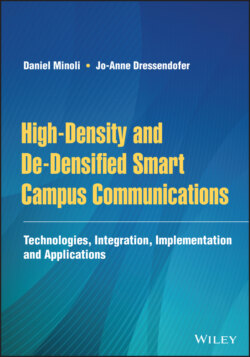Читать книгу High-Density and De-Densified Smart Campus Communications - Daniel Minoli - Страница 10
Оглавление
PREFACE
High‐density campus communications have traditionally been important in many environments, including airports, stadiums, convention centers, shopping malls, classrooms, hospitals, cruise ships, train and subway stations, evangelical megachurches, large multiple dwelling units, boardwalks, (special events in) parks, dense smart cities, and other venues. These communications span several domains: people‐to‐people, people‐to‐websites, people‐to‐applications, sensors‐to‐cloud analytics, and machines‐to‐machines/device‐to‐device. While the later Internet of Things (IoT) applications are generally (but not always) low speed, the former applications are typically high speed. In many settings, people access videos (a la Over The Top [OTT] mode) or websites and applications that often include short videos or other high data‐rate content. Deploying optimally performing high‐density campus communication systems is desired and required in many cases, but it can, at the same time, be a complex task to undertake successfully.
High‐density campus communications play a role in the evolution of Smart Campuses but also drive the Smart City and Smart Building use cases. Connectivity is now considered a fourth utility (in addition to gas, water, and electricity). In fact, massive‐type communication is a recognized requirement of 5G, even if just in the machine‐type communication environment. In the campus applications just cited, people‐to‐people, people‐to‐websites, and people‐to‐applications connectivity is increasingly important, given that nearly everyone now carries a smartphone and many apps entail high‐throughput transmissions.
There are unique requirements and unique designs required for high‐density communications, particularly because of the relative scarcity of available spectrum. In addition, there has been and continues to be a set of transitions, even transformations, of the underlying technologies. The world has moved to IP for all data, voice, and video communications. Additionally, there is a trend toward the use of Wi‐Fi‐based hotspot communication in all practical situations, due to near ubiquity of service, lower end‐user costs, higher bandwidth, technical simplicity, lower infrastructure costs, decentralized administration, regulation relief, and non‐bureaucratic delivery of service (without the reliance of large institutional providers). While 5G promises to deliver a set of new capabilities, neither 3G nor 4G displaced Wi‐Fi as a common access technology in the office, in the campus, on the street, and in travel. The technologies per se used for high‐density communications are not new (perhaps with the exception of 5G), but the requirements, as well as the design and system synthesis, are relatively unique.
As the second decade of the twenty‐first century rolled along, however, a new requirement presented itself due to the worldwide pandemic: physical/desk distancing in support of Office Social Distancing (OSD) and Office Dynamic Cluster Monitoring and Analysis (ODCMA). Wireless technologies have been harvested to address and manage these pressing issues. Real‐Time Locating Systems (RTLS) have been employed for a number of years to automatically identify and then track the location of objects or people in real‐time, within a building, or in other constrained locations are seeing renewed interest and applications. Even if effective vaccines are found and distributed globally, the common opinion is that many (but not all) societal and workplace changes driven by the pandemic may become permanent.
This book assesses the requirements, technologies, designs, solutions, and trends associated with High‐Density Communications (HDC). We believe this to be the first book that specifically synthesizes the topic of applied high‐density communications. Chapter 1 looks at the functional requirements for high‐density communications. Chapter 2 discusses the traditional data/Wi‐Fi Internet access, including OTT video. Chapter 3 addresses the traditional voice/cellular design for campus applications, especially the Distributed Antenna System (DAS). Chapter 4 peruses the traditional sensor networks/IoT services approaches. Chapter 5 is the core of this text and examines evolved Wi‐Fi hotspot connectivity and related technologies (Wi‐Fi 5, Wi‐Fi 6, spectrum, IoT, VoWiFi, DASs, microcells issues, 5G versus Wi‐Fi issues), as well as intelligent integration of the discrete set of campus/venue networks into a cohesive platform usable in airports, stadiums, convention centers, classrooms, hospitals, and the like.
Chapter 6 starts the discussion on de‐densification, using the same kind of technologies discussed in part one of the book; it considers the topic of office social distancing and discusses one of the available technologies. Chapter 7 covers the use of Ultra‐Wideband (UWB) technologies. Chapter 8 addresses the office social distancing challenge using Wi‐Fi, Bluetooth, and cellular/smartphone methodologies. Chapter 9 provides a use case for HDC systems, and Chapter 10 offers a pragmatic view for some of the economics of broad deployment of HDC.
The book is targeted to networking professionals, technology planners, campus administrators, service providers, equipment vendors, and educators. It is not a research monograph, but rather it aims at integrating the real‐world deployment of technologies, strategies, and implementation issues related to delivering an actual working HDC environment in any of the key venues listed above. It is important to note that the composition of this book started in February 2020. While social distancing in the office and public venues was a crucial short‐term goal at press time, the business‐ and public‐venue density requirements will likely resurge over time, likely with some yet to be foreseen modifications.
Many books delve extensively on general technologies of all types; however, they fall short in terms of the economics of such technologies, deployment challenges, associated security issues, and most lack tangible case studies. This book addresses these key aspects, based on actual deployment by the team associated with this writing, at a top US airport.
Some portions of this text make use of patent material filed with the United States Patent Office. All inventors cited are implicitly acknowledged for their contribution to this synthesis.
Daniel Minoli
DVI Communications
Jo‐Anne Dressendofer
Slice Wireless Solutions
30 December 2020
